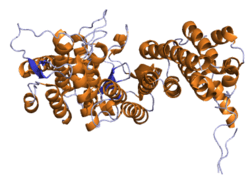MEN1
Menin is a protein that in humans is encoded by the MEN1 gene.[1] Menin is a putative tumor suppressor associated with multiple endocrine neoplasia type 1 (MEN-1 syndrome).[2]
In vitro studies have shown that menin is localized to the nucleus, possesses two functional nuclear localization signals, and inhibits transcriptional activation by JunD. However, the function of this protein is not known. Two messages have been detected on northern blots but the larger message has not been characterized. Two variants of the shorter transcript have been identified where alternative splicing affects the coding sequence. Five variants where alternative splicing takes place in the 5' UTR have also been identified.[1]
History
In 1988, researchers at Uppsala University Hospital and the Karolinska Institute in Stockholm mapped the MEN1 gene to the long arm of chromosome 11.[3] The gene was finally cloned in 1997.[4]
Genomics
The gene is located on long arm of chromosome 11 (11q13) between base pairs 64,570,985 and 64,578,765. It has 10 exons and encodes a 610-amino acid protein.
Over 1300 mutations have been reported to date (2010). The majority (>70%) of these are predicted to lead to truncated forms are scattered throughout the gene. Four - c.249_252delGTCT (deletion at codons 83-84), c.1546_1547insC (insertion at codon 516), c.1378C>T (Arg460Ter) and c.628_631delACAG (deletion at codons 210-211) have been reported to occur in 4.5%, 2.7%, 2.6% and 2.5% of families.[2]
Clinical implications
The MEN1 phenotype is inherited via an autosomal-dominant pattern and is associated with neoplasms of the pituitary gland, the parathyroid gland, and the pancreas (the 3 "P"s). While these neoplasias are often benign (in contrast to tumours occurring in MEN2A), they are adenomas and, therefore, produce endocrine phenotypes.
MEN1 pituitary tumours are adenomas of anterior cells, typically prolactinomas or growth hormone-secreting. Pancreatic tumours involve the islet cells, giving rise to gastrinomas or insulinomas. In rare cases, adrenal cortex tumours are also seen.
Interactions
MEN1 has been shown to interact with:
References
- ↑ 1.0 1.1 "Entrez Gene: MEN1 multiple endocrine neoplasia I".
- ↑ 2.0 2.1 Thakker RV (June 2010). "Multiple endocrine neoplasia type 1 (MEN1)". Best Pract. Res. Clin. Endocrinol. Metab. 24 (3): 355–70. doi:10.1016/j.beem.2010.07.003. PMID 20833329.
- ↑ Byström C, Larsson C, Blomberg C, Sandelin K, Falkmer U, Skogseid B et al. (March 1990). "Localization of the MEN1 gene to a small region within chromosome 11q13 by deletion mapping in tumors". Proc. Natl. Acad. Sci. U.S.A. 87 (5): 1968–72. doi:10.1073/pnas.87.5.1968. PMC 53606. PMID 1968641.
- ↑ Chandrasekharappa SC, Guru SC, Manickam P, Olufemi SE, Collins FS, Emmert-Buck MR et al. (April 1997). "Positional cloning of the gene for multiple endocrine neoplasia-type 1". Science 276 (5311): 404–7. doi:10.1126/science.276.5311.404. PMID 9103196.
- ↑ Jin S, Mao H, Schnepp RW, Sykes SM, Silva AC, D'Andrea AD et al. (July 2003). "Menin associates with FANCD2, a protein involved in repair of DNA damage". Cancer Res. 63 (14): 4204–10. PMID 12874027.
- ↑ 6.0 6.1 Heppner C, Bilimoria KY, Agarwal SK, Kester M, Whitty LJ, Guru SC et al. (August 2001). "The tumor suppressor protein menin interacts with NF-kappaB proteins and inhibits NF-kappaB-mediated transactivation". Oncogene 20 (36): 4917–25. doi:10.1038/sj.onc.1204529. PMID 11526476.
- ↑ Agarwal SK, Guru SC, Heppner C, Erdos MR, Collins RM, Park SY et al. (January 1999). "Menin interacts with the AP1 transcription factor JunD and represses JunD-activated transcription". Cell 96 (1): 143–52. doi:10.1016/S0092-8674(00)80967-8. PMID 9989505.
- ↑ Yokoyama A, Wang Z, Wysocka J, Sanyal M, Aufiero DJ, Kitabayashi I et al. (July 2004). "Leukemia Proto-Oncoprotein MLL Forms a SET1-Like Histone Methyltransferase Complex with Menin To Regulate Hox Gene Expression". Mol. Cell. Biol. 24 (13): 5639–49. doi:10.1128/MCB.24.13.5639-5649.2004. PMC 480881. PMID 15199122.
- ↑ Sukhodolets KE, Hickman AB, Agarwal SK, Sukhodolets MV, Obungu VH, Novotny EA et al. (January 2003). "The 32-Kilodalton Subunit of Replication Protein A Interacts with Menin, the Product of the MEN1 Tumor Suppressor Gene". Mol. Cell. Biol. 23 (2): 493–509. doi:10.1128/MCB.23.2.493-509.2003. PMC 151531. PMID 12509449.
- ↑ Lopez-Egido J, Cunningham J, Berg M, Oberg K, Bongcam-Rudloff E, Gobl A (August 2002). "Menin's interaction with glial fibrillary acidic protein and vimentin suggests a role for the intermediate filament network in regulating menin activity". Exp. Cell Res. 278 (2): 175–83. doi:10.1006/excr.2002.5575. PMID 12169273.
Further reading
- Tsukada T, Yamaguchi K, Kameya T (2002). "The MEN1 gene and associated diseases: an update". Endocr. Pathol. 12 (3): 259–73. doi:10.1385/EP:12:3:259. PMID 11740047.
- Kong C, Ellard S, Johnston C, Farid NR (2002). "Multiple endocrine neoplasia type 1Burin from Mauritius: a novel MEN1 mutation". J. Endocrinol. Invest. 24 (10): 806–10. doi:10.1007/bf03343931. PMID 11765051.
- Thakker RV (2002). "Multiple endocrine neoplasia". Horm. Res. 56 Suppl 1: 67–72. doi:10.1159/000048138. PMID 11786689.
- Stowasser M, Gunasekera TG, Gordon RD (2002). "Familial varieties of primary aldosteronism". Clin. Exp. Pharmacol. Physiol. 28 (12): 1087–90. doi:10.1046/j.1440-1681.2001.03574.x. PMID 11903322.
- Kameya T, Tsukada T, Yamaguchi K (2004). "Recent advances in MEN1 gene study for pituitary tumor pathogenesis". Frontiers of hormone research. Frontiers of Hormone Research 32: 265–91. doi:10.1159/000079050. ISBN 3-8055-7740-0. PMID 15281352.
- Balogh K, Rácz K, Patócs A, Hunyady L (2007). "Menin and its interacting proteins: elucidation of menin function". Trends Endocrinol. Metab. 17 (9): 357–64. doi:10.1016/j.tem.2006.09.004. PMID 16997566.
- Lytras A, Tolis G (2006). "Growth hormone-secreting tumors: genetic aspects and data from animal models". Neuroendocrinology 83 (3–4): 166–78. doi:10.1159/000095525. PMID 17047380.
External links
- GeneReviews/NIH/NCBI/UW entry on Multiple Endocrine Neoplasia Type 1
- MEN1 gene variant database
- MEN1 protein, human at the US National Library of Medicine Medical Subject Headings (MeSH)

